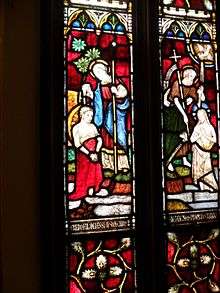Philip the Evangelist
| Saint Philip the Evangelist | |
|---|---|
 | |
| Evangelist or Deacon | |
| Born |
Unknown (1st century) Caesarea, Israel |
| Died | 11th October (1st century) |
| Venerated in |
Coptic Orthodox Church Armenian Apostolic Church Ethiopian Orthodox Church Syriac Orthodox Church Oriental Orthodoxy, Lutheranism |
| Feast | 11th October |
Saint Philip the Evangelist (Greek: Φίλιππος, Philippos) appears several times in the Acts of the Apostles. He was one of the Seven chosen to care for the poor of the Christian community in Jerusalem (Acts 6). He preached and performed miracles in Samaria, and met and baptised an Ethiopian man, a eunuch, in Gaza, traditionally marking the start of the Ethiopian Church (Acts 8). Later, he lived in Caesarea Maritima with his four daughters who foretold, where he was visited by Paul the Apostle (Acts 21).
New Testament
Philip bore a Greek name. He is first mentioned in the Acts of the Apostles (6:5) as one of "the seven" who were chosen to attend to certain temporal affairs of the church in Jerusalem in consequence of the murmurings of the Hellenists against the Hebrews.
After the martyrdom of Saint Stephen he went to "the city of Samaria", where he preached with much success, Simon Magus being one of his converts. He afterwards was told by an angel of the Lord to go to the road between Jerusalem and Gaza. There he instructed and baptized the Ethiopian eunuch; next he was "caught away" by the Spirit and "found at Azotus" (Ashdod), and then "pass[ed] through he preached in all the cities till he came to Caesarea" (Acts 8).
Here some years afterwards, according to Acts 21:8–9, where he is described as "the evangelist" (a term found again in the New Testament only in Ephesians 4:11; 2 Timothy 4:5), he entertained Paul the Apostle and his companion on their way to Jerusalem; at that time "he had four daughters which did prophesy".[1]
Tradition

At a very early period he came to be confused with the Philip the Apostle; the confusion was all the more easy because, as an esteemed member of the apostolic company, he may readily have been described as an apostle in the wider sense of that word, beyond the original 12 Apostles.[2] A late tradition describes him as settling at Tralles in Anatolia, where he became the bishop of that church.[1]
"St Philip the Deacon" is commemorated on October 11 in the Catholic Church,[3] the Lutheran Church-Missouri Synod,[4] and the Episcopal Church (USA).[5] In the Eastern Orthodox Church, Philip is counted among the Seventy Apostles, and is referred to as a Protodeacon; his feast day is celebrated on June 6. St. Philip's feast day is celebrated in The Episcopal Church but not in other Anglican churches. He was added to the Calendar of Saints because he is the patron saint for the Cathedral of St. Philip in the Episcopal Diocese of Atlanta.
Notes
- 1 2
 One or more of the preceding sentences incorporates text from a publication now in the public domain: Chisholm, Hugh, ed. (1911). "Philip "the Evangelist"". Encyclopædia Britannica. 21 (11th ed.). Cambridge University Press. p. 376.
One or more of the preceding sentences incorporates text from a publication now in the public domain: Chisholm, Hugh, ed. (1911). "Philip "the Evangelist"". Encyclopædia Britannica. 21 (11th ed.). Cambridge University Press. p. 376. - ↑ see further George Salmon, Introduction to the New Testament, 7th ed., p. 313 sqq.
- ↑ "Martyrologium Romanum", Typis Vaticanis, Editio Altera, 2004, entry for 11 October
- ↑ "Lutheranism 101, Scot A. Kinnaman, p. 278
- ↑ Calendar of saints (Episcopal Church in the United States of America)
External links
- Apostle Philip the Deacon of the Seventy Orthodox icon and synaxarion
- Who is St. Philip the Evangelist
- IVP New Testament Commentary on Philip in Acts 8